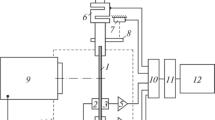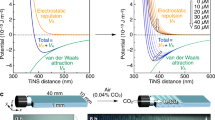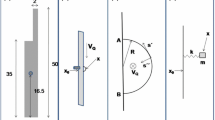Abstract
Crystal grains of solid \(^4\)He can move in relation to each other even when embedded inside the solid [1, 2]. In this work, we characterize a macroscopic motion of solid hcp \(^4\)He composed of such grains. Motion is induced by applying an external torque to the solid contained inside an annular channel mounted on a torsional oscillator. In order to characterize the surface of the moving solid, we developed an in situ flow detection method using a sensitive “microphone” embedded in the wall of the channel. Motion is detected by counting the vibrations induced by rows of He atoms moving past the microphone. Such vibrations were detected only at T = 0.5 K, our lowest temperature. At this temperature, the measured dissipation associated with the solid He is zero within our accuracy. Our results indicate that the orientation of the surface of the moving solid is the (0001) basal plane of the hcp structure. At T = 0.5 K, we found that for speeds \({<}7\,\upmu \)m/s, the solid flows without detectable friction.








Similar content being viewed by others
References
O. Pelleg, M. Shay, S.G. Lipson, E. Polturak, J. Bossy, J.C. Marmeggi, K. Horibe, E. Farhi, A. Stunault, Phys. Rev. B 73, 024301 (2006)
C.A. Burns, N. Mulders, L. Lurio, M.H.W. Chan, A. Said, C.N. Kodituwakku, P.M. Platzman, Phys. Rev. B 78, 224305 (2008)
E. Kim, M.H.W. Chan, Nature 427, 225 (2004)
D.Y. Kim, M.H.W. Chan, Phys. Rev. Lett. 109, 155301 (2012)
Xiao Mi, Anna Eyal, A. V. Talanov, and J. D. Reppy, arXiv:1407.1515
G. Nichols, M. Poole, J. Nyeki, J. Saunders, and B. Cowan, arXiv:1311.3110
J. Day, J. Beamish, Nature 450, 853 (2007)
A. Haziot, A.D. Fefferman, F. Souris, J.R. Beamish, H.J. Maris, S. Balibar, Phys. Rev. B 88, 014106 (2013)
X. Rojas, A. Haziot, V. Bapst, H.J. Maris, S. Balibar, Phys Rev. Lett. 105, 145302–5 (2010)
A. Haziot, X. Rojas, A.D. Fefferman, J.R. Beamish, S. Balibar, Phys Rev Lett. 110, 035301 (2013)
M.A. Paalanen, D.J. Bishop, H.W. Dail, Phys. Rev. Lett. 46, 664 (1981)
F. Tsuruoka, Y. Hiki, Phys. Rev. B 20, 2702 (1979)
J.B. Pendry, New J Phys. 12, 03302814 (2010)
V.L. Popov, Phys. Rev. Lett. 83, 1632 (1999)
A. Eyal, E. Livne, and E. Polturak (yet to be published)
A.C. Clark, J.D. Maynard, M.H.W. Chan, Phys. Rev. 77, 184513 (2008)
A. Eyal, O. Pelleg, L. Embon, E. Polturak, Phys. Rev. Lett. 105, 025301 (2010)
A. Eyal, E. Polturak, Jour. Low Temp. Phys. 163, 262 (2011)
A. Eyal, E. Polturak, J. Low Temp. Phys. 168, 117 (2012)
L. Pollet, M. Boninsegni, A. Kuklov, N. Prokofev, B. Svistunov, M. Troyer, Phys. Rev. Lett. 98, 135301 (2007)
H. Lauter, V. Apaja, I. Kalinin, E. Kats, M. Koza, E. Krotscheck, V.V. Lauter, A.V. Puchkov, Phys. Rev. Lett. 107, 265301 (2011)
Acknowledgments
We acknowledge useful discussions with A. Auerbach and B. Svistunov. We thank A. Danzig, S. Hoida, and L. Yumin for their assistance. This work was supported by the Israel Science Foundation and by the Technion Fund for Research.
Author information
Authors and Affiliations
Corresponding author
Appendix: Finite Element Analysis
Appendix: Finite Element Analysis
Clark et al.[16] were the first to point out that the resonance frequency of the TO can be affected by the changes of the shear modulus of the solid He. Specifically, they addressed the low-temperature anomalies reported by Kim and Chan[3] around 0.2K. The shear modulus of the solid changes significantly around this temperature[7]. Over the temperature range of our experiment (0.5–2K), the shear modulus changes by about 30%, as reported by Paalanen, et al.[11]. The shear modulus increases gradually towards low temperatures. To see how this affects our experiment, we performed a Finite Element Analysis of our TO. We simulated two different situations. First, we checked the decrease of the resonant period resulting from the increase of the shear modulus as the temperature is reduced from 2 to 0.5K. The simulated decrease in this case is about 7 nsec, while our observed decrease of the period (due to what we call ”mass decoupling”)is typically between 0.6 and 1 \(\upmu \)sec, a hundred times larger. In addition, the elastic properties of the solid change smoothly as the temperature decreases from 2 to 0.5K, while in our experiment the majority of the period shift occurs over a 10 mK interval near the temperature at which the crystal was grown. We conclude that our observations cannot be explained by the temperature dependence of the shear modulus of solid He.
Another scenario which we checked in conjunction with the decrease of the resonant period which we see (Figs. 2, 3) is the following: Suppose that at the end of growth, a small amount of liquid remains trapped in the cell so that the solid is not fully coupled with the walls of the TO. Once the cell is cooled, this liquid freezes and the solid He becomes coupled to the walls. This coupling might perhaps make the TO ”stiffer”, increase the effective torsion constant, and decrease the period. To check this scenario, we extended the finite element analysis to simulate the TO in several configurations where some fluid is present in the cell in different locations. To illustrate what we did, we show one such configuration in the Fig. 9. In this particular configuration the coupling of the solid He to the walls is minimal, and so the presence of the liquid had the largest effect. The simulated period of the TO was compared with that of a cell filled with solid. Since the amount of solid He (and moment of inertia) of the cell containing fluid is different than that of a cell filled with solid, for each configuration we carried out a series of FEA simulations with different amounts of liquid and extrapolated to zero liquid content. The extrapolated value was used in the comparison.
Schematic illustration of a typical simulated configuration of having both liquid and solid inside the cell. a shows a schematic cross section of our TO filled with solid He. b show a situation where the solid He is attached to the wall of the cell only at the bottom, while a thin layer of liquid separates the solid from all the other walls (Color figure online)
For the configuration shown in Fig. 9, in the limit of zero liquid content, the simulated period shift is (+)71 nsec. This should be compared to the observed shift of (\(-\))0.6 to (\(-\))1 \(\upmu \)sec in different crystals and TOs. The difference in sign results from the fact that in the accelerated frame of the TO, a fictitious DAlambert force acts on the solid He during the oscillation. Due to its small resistance to shear, in the presence of liquid the solid He is free to deform slightly under this force and so effectively it appears to oscillate in antiphase to the motion of the TO. This type of response increases the effective torsion constant and so the effective period is smaller. When the cell is filled with solid, this internal oscillation does not take place, the additional contribution of the solid He to the effective torsion constant is now smaller and so the period increases. This gives the (+) sign. In all cases, we found that the simulated period shift was of the opposite sign and at least an order of magnitude smaller than what we observed in the experiment. We conclude that the presence of liquid cannot explain our observations.
Rights and permissions
About this article
Cite this article
Livne, E., Eyal, A., Scaly, O. et al. Characterization of the Surface of Moving Solid \(^4\)He. J Low Temp Phys 180, 185–199 (2015). https://doi.org/10.1007/s10909-015-1308-8
Received:
Accepted:
Published:
Issue Date:
DOI: https://doi.org/10.1007/s10909-015-1308-8





